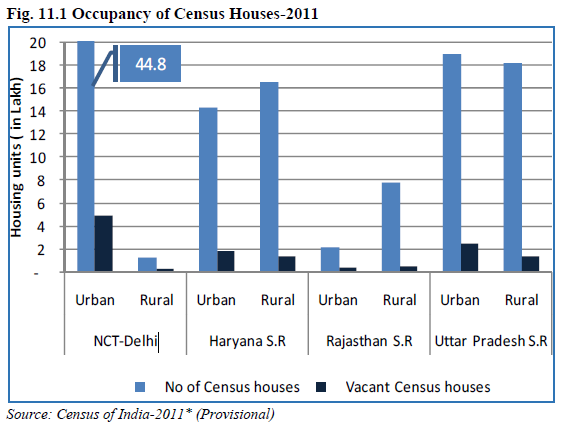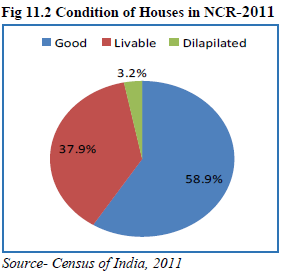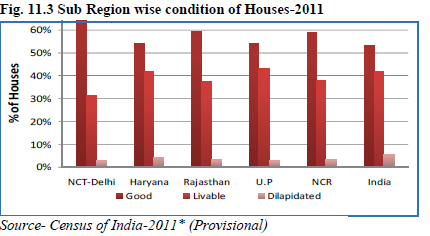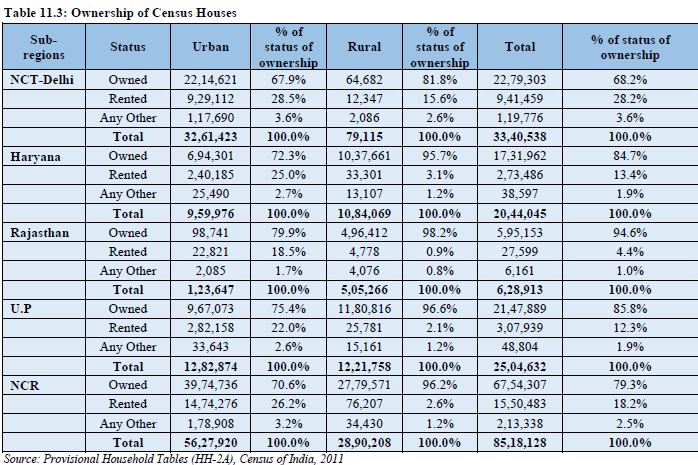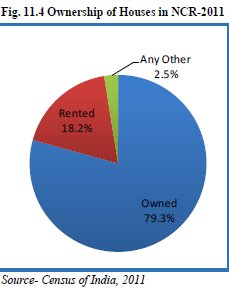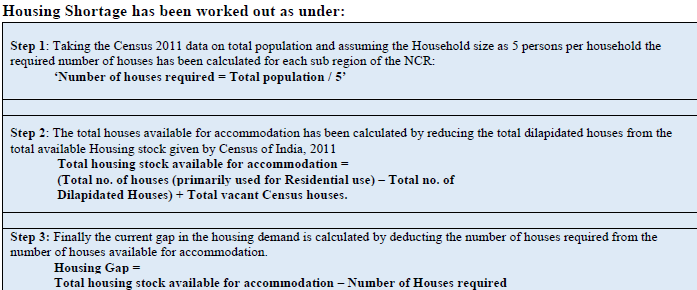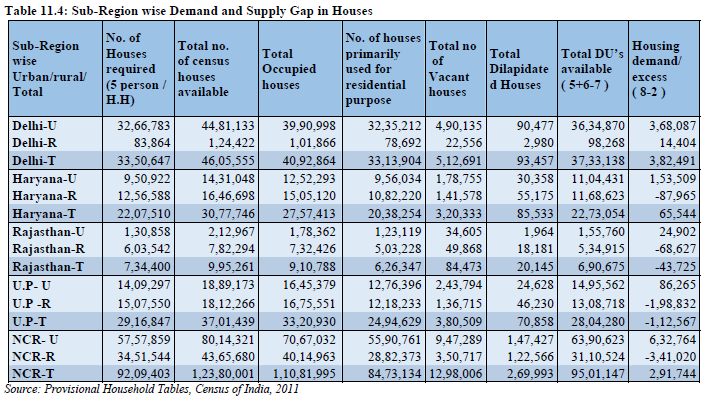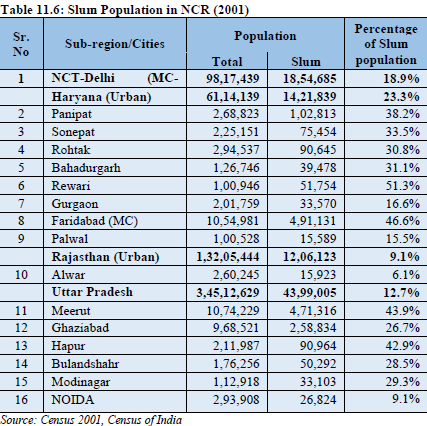National Capital Region (India): Shelter
This article has been sourced from an authoritative, official readers who wish to update or add further details can do so on a ‘Part II’ of this article. |
Contents |
The source of this article
Draft Revised Regional Plan 2021: National Capital Region
July, 2013
National Capital Region Planning Board, Ministry of Urban Development, Govt. of India, Core-4B, First Floor, India Habitat Centre, Lodhi Road, New Delhi-110003
National Capital Region Planning Board
National Capital Region (India) : Shelter
BACKGROUND
Housing is a basic necessity and an important component of human settlement planning. Demand and supply gap in housing leads to proliferation of slums and unauthorized development. In NCR, housing for migrants is also a concern as Delhi attracts migrants from all parts of the country in addition to the floating population. A number of public agencies like state housing boards, local bodies, area development authorities, etc. are involved in creating both developed plots and built-up dwelling units. Central government agencies and PSU’s like NBCC, HUDCO etc. have contributed to the creation of housing stock in NCR. Besides, Cooperative Societies and Private Developers have also added to the housing stock.
EXISTING HOUSING SCENARIO IN THE NCR
11.2.1 Housing Stock
As per Census 2011, there are 85, 18,128 Households in NCR, while the number of census houses* are 1,23,80,001 indicating that the quantum of census house is more than the households (ratio- ‘1:1.45’), but in reality only 84, 73,134 (i.e. 68.8%) houses are used primarily for residential purpose and the other census houses are being used as shops, offices, schools, colleges, hotels, lodges, guest house, dispensary, workshop, place of worship etc. Of the total census houses, 89.5% are occupied and the remaining 10.5% are vacant as shown in Table 11.1 (Fig. 11.1). Out of the 110.8 Lakh occupied houses, about 1.8 % houses were found locked at the time of census.
- Note – Census houses are defined as "any permanent structure which on land, serves or would serve for the accommodation of human beings,
or of animals, or goods of any description provided always that it could not be struck and removed bodily like a tent or a mud hut".
44.8
NCT Delhi has 37.2 percent of the total census houses in NCR, followed by sub regions of Uttar Pradesh (30%), Haryana (25%) and Rajasthan (8%). The highest number of vacant houses is in NCT-Delhi (11.1%) and the least is in Rajasthan Sub-Region (8.5%). In the urban areas of NCR, Rajasthan sub-region has the highest proportion of vacant houses (16.2%), followed by Uttar Pradesh and Haryana where the percentage of vacant houses are 12.9% and 12.5% respectively. In the rural areas of NCR, NCT-Delhi has the highest percentage of vacant houses (18.1%), followed by Haryana and Uttar Pradesh where the percentage of vacant houses are 8.6 percent and 7.5 percent respectively.
It is observed that about 18.6% and 18.7 % of the houses are lying vacant in Gurgaon district and Gautam Budh Nagar district respectively.
11.2.2 Condition of Houses: Qualitative analysis of the housing stocks used for residential purposes in NCR reveals that while 58.9% of these houses are in good condition, 37.9% are in livable condition and 3.2 % houses are in dilapidated condition. Proportion of Good houses in NCR is more in the urban areas (64.7 %) whereas the proportion of livable houses (48.0%) is more in rural areas. NCT Delhi has the highest percentage of good quality houses in NCR (66%) (Fig. 11.2 and Table 11.2).
The percentage of dilapidated houses is more in rural areas (4.2%) as compared to urban areas (2.6%) in NCR. The quality of housing in NCR is relatively better than India’s average. About 54% houses in Haryana and U.P sub-regions have been classified as good quality housing (Fig.11.3).
11.2.3 Housing Ownership
Census 2011 data on ownership status of houses reveals that 79.3% of the houses in NCR are self owned houses, whereas 18.2% fall under ‘rented’ category (Table 11.3). The Technical Group on Urban Housing Shortage (2012-17) constituted by ‘Ministry of Housing and Urban Poverty Alleviation’ has clubbed “any other” category with the rented category as it contains those living in employer provided housings, etc. (Fig. 11.4). The percentage of owned houses is the highest in Rajasthan (94.6%) and the lowest in NCT-Delhi (68.2%). It is seen that 28.2% of the houses in Delhi fall under the rented category. At district level, the percentage of rented houses is the highest in Gurgaon (31%), followed by Gautam Budh Nagar (28%), Faridabad (20%), Ghaziabad (17%), Panipat (15%) and Sonepat (10%).
11.2.4 Demand and Supply Gap
As mentioned earlier the total number of census houses in 2011 out-numbers the households in absolute terms, but in fact 68.8% houses are used primarily for residential purposes. Housing shortage has been calculated by the Technical group on urban housing shortage of the Ministry of Housing and Urban Poverty Alleviation (MoHUPA), based on excess of households over housing stock, number of households residing in unacceptable dwelling units, obsolescence factor, congestion factor and homeless people. In the absence of availability of information on all these parameter, NCRPB has estimated the housing demand and supply gap for the year 2011 using the following methodology.
The demand and supply gap analysis in housing reveals that there is an overall excess of housing stock in NCR. In NCR urban areas there are 6.32 Lakh houses in excess but in the NCR rural areas there is a housing shortage of 3.41 Lakh. In Delhi and Haryana sub-region the number of housing stock is in excess by 3.82 Lakh and 0.66 Lakh units respectively. But in Uttar Pradesh and Rajasthan sub-regions there is housing deficit of 1.12 Lakh and 0.44 Lakh units respectively. But in the urban areas of all the subregions, the housing stock is in excess to the demand (Table 11.4). ‘Report of the ‘Technical Group on Housing shortage (2012-17), Government of India, M/O Housing and Urban Poverty Alleviation’ has analyzed the picture comprehensively taking all the relevant factors into consideration and indicated housing shortage at state level in the NCR. Hence the limited analysis of demand and supply of housing attempted above may not reveal the correct picture.’
11.2.5 Slums
Economic vibrancy of large urban centres offering livelihood opportunities is the chief cause of inmigration to the urban areas and migration has played a significant role in accelerated urban growth. Migration to the urban areas for livelihood takes place regardless of the inadequacies in the physical infrastructure.
Planned urbanization has been marred to an extent by the huge demand for basic amenities resulting in deterioration of physical living environment. Lack of housing is resulting in increase in the land prices, which forces the urban poor to settle for informal solutions resulting in mushrooming of slums and squatter settlements. Such unauthorized squatter settlements, bereft of basic amenities, are not only overcrowded and unhygienic but also prone to various environmental hazards.
The first attempt to collect detailed data about slum areas of the country was made during Census-2001 particularly in cities/ towns having a population of 50,000 or more based on census 1991 data. All the habitation/ cluster of poorly built houses, which have been notified as slums by the State Government under any legal provision or recognized by them as such, have been accordingly considered as slum population for this purpose. Besides areas in cities/towns, which satisfy the usual criteria for declaring an area as slum have also been included. In India 42.6 million people were living in the slums in 640 cities in 2001, out of which 4.8 percent were in NCT-Delhi. In 2001, 14.6 percent of the total HH’s in Delhi Municipal Corporation were living in slums, which is comparatively lesser than other Million plus cities like Greater Mumbai, Kolkata and Chennai. Only Bangalore (M.C) has lesser slum HH’s population as compared to Delhi (Table 11.5).
Delhi continues to face the problem of mushrooming growth of Jhuggi-Jhopri (JJ) Clusters on land pockets belonging to various land owning agencies i.e., DDA, MCD, NDMC, Delhi Cantonment Board, Railways, Government Departments, CPWD, L&DO, Departments of Delhi Government and other autonomous organizations. Slum Population in major towns of NCR in 2001 is given in Table 11.6.
11.2.6 Efforts towards Improvement of Slums in NCR.
A) NCT Delhi Sub-Region Delhi Urban Shelter Improvement Board (DUSIB) is providing shelter to shelter less people in Delhi through permanent night shelters and temporary shelter. The schemes for providing basic services in JJ clusters being implemented by DUSIB includes construction of roads, brick pavements, road- side drains, street lights, Sishu Vatika, Basti Vikas Kendra/Community Centers, Community Toilets/Bath. As on 2013, 44 J.J. Resettlement Colonies have been provided with facilities of piped water supply, sewerage, street lights, parks, community centers, etc.
Night Shelters are important during the winter season for the homeless. In 2001 in Delhi, there were 23 government run/ managed shelters for homeless, which increased to 47 in 2005 and 148 in 2010. There is a proposal to increase the numbers of such shelters to 173 by 2013. Many of these night shelters run above its capacity and such growth in night shelter also indicates large scale migration of poor and homeless to Delhi. Therefore NCRPB has requested adjoining towns of Delhi in the NCR, namely, Gurgaon, Noida, Greater Noida, Ghaziabad, etc. to create adequate number of night-shelters for which NCRPB will also provide financial assistance.
B) Haryana Sub-Region
In Haryana the provision of housing for EWS/ LIG is being done through Haryana Housing Board. Haryana Slum Clearance Board is the nodal agency availing financial assistance from financial institutions like HUDCO and NCRPB etc with an objective to undertake re-development of slum areas and relocation and rehabilitation of slum dwellers in the State. In Faridabad five night shelters exist and four more are proposed to be constructed. One night shelter is also proposed at Bahadurgarh.
C) Uttar Pradesh Sub-Region Awas and Saheri Niyojan Anubhag-3 has launched a policy to provide housing for EWS/ LIG segment. The policy has reservation of 10% units each for EWS and LIG section. It is the responsibility of the developer to ensure provision of EWS / LIG units as per policy. The policy also provides that if the construction of EWS/ LIG units is not possible within the project area then it can be provided in a close-by location. Completion certificate will be issued to the developer only after the developer has completed the construction of EWS/ LIG housing. It is also provided that FAR and ground coverage utilised for EWS/ LIG units can be utilised by the developer in its project over and above the allowed FAR, as an incentive.
D) Rajasthan Sub-Region To address the housing situation of EWS / LIG segments, Government of Rajasthan has initiated an affordable housing policy with PPP intervention having special focus on EWS/ LIG households to arrest the growth of slums. The policy attempts to create adequate housing stock at rates that are affordable to the poorer income groups, with increased participation of private sector through investments on PPP model. The policy also addresses the requirements of transit accommodation for migrants through creation of rental housing.
ISSUES
A) In the NCR, 10 percent of the Census Houses are lying vacant and are not put to productive use, which is relatively higher than the national average of 7.5 percent.
B) Though the absolute number of census housing units exceeds the number of households, still there is significant proportion of squatter families in NCR as these units are beyond the affordability limits of the end user. Fast growing towns like Noida, Greater Noida, and Ghaziabad etc. have witnessed tremendous surge in the real estate activities in the past decade which has lead to creation of a lot of housing stocks. The Gap between the end user’s affordability and the rising price of dwelling units has been increasing constantly.
C) It is observed that presently 18.2% of the houses in the NCR are under rented category. D) NCR has 2.92 Lakhs houses in excess to its demand. In the urban areas of NCR there are 6.33 Lakhs houses in excess where as in the rural areas there is a deficit of 3.41 Lakh houses. On release of detailed census 2011 data on number of households, congestion in housing, age of housing it will have to be re-worked out.
HOUSING SCHEMES AND POLICIES
There are many social welfare schemes and policies of Government of India which specifically address the issues related to urban and rural housing. As part of the JNNURM launched by the Government of India in December 2005 for a period of 7 years, ‘Basic Services to Urban Poor’ (BSUP) and ‘Integrated Housing and Slum Development Programme’ (IHSDP) component dealt with housing, slum development and urban poverty issues.
A) Rajiv Awas Yojana (RAY) Phase – II In XIIth Five year Plan, BSUP and IHSDP would be part of Rajiv Awas Yojana. There will be another scheme for slum rehabilitation in cities not covered under RAY. Main feature of RAY are:
i. It is based on a holistic approach envisaging in situ rehabilitation of slum so that the livelihood opportunities of the dwellers are not disrupted. ii. It mandates giving property rights to slum dwellers by suitable enactment to earmark 20-25 percent of developed land for housing projects for EWS / LIG category and earmarking of at least 25% of budget of municipal and other such body which provide basic urban services to urban poor.
B) Rural Housing As part of improving basic amenities in rural India, housing is an important initiative. Indira Awas Yojana (IAY) launched since 1985 continued during the Eleventh plan period. The scheme is accessible to the poorest in rural India. In the Twelfth plan, it is proposed to increase the unit assistance for house construction under Indira Awas Yojana to Rs. 65,000 in plain areas and to Rs 70,000 in hilly / difficult areas with an increase each year to absorb rising cost of material and labour. It will help in bringing improvement in quality of housing given the scale of shelter-lessness and the need for improving quality. It is important that local stakeholders are able to effectively participate in housing delivery. PRIs are central to effective habitat development in rural areas C) National Urban Housing & Habitat Policy, 2007 The Policy seeks to set in motion a process for providing Affordable Housing for all, particularly for the economically weaker sections and lower income groups.
Key features of the policy include: Focus on affordable housing for all, with an emphasis on inclusive urban planning increasing the supply of land and addressing the housing shortages; Provision of a decent shelter to the urban poor; Reservation of 10-15% of land in every new public/ private housing projects or 20-25% of Floor Area Ratio (FAR) for Economically Weaker Sections (EWS)/Lower Income Group (LIG); Emphasis on private sector participation through the use of tools like Transferable Development Rights (TDR), additional FAR, and mechanisms to facilitate land assembly by the private sector; and
Recognition of the need for subsidy coupled with suitable financial instruments to establish a flow of institutional funds for the poor for housing, without harassment.
D) Draft National Slum Policy, 2001
The policy primarily endorses and promotes an upgrading and improvement approach to deal with slums and informal settlements as opposed to resettlement. It proposes that all existing planning instruments such as master plans, land use plans etc. should be modified to ensure that slums and informal settlements can be properly integrated into the wider urban area. The policy states that all physical upgrading and improvement in informal settlements should adopt a community-based approach with the active involvement of members of the community at every stage of design, implementation, and maintenance of services and assets. It sets forth specific norms and guiding
Box 11.2
Rajiv Awas Yojana (RAY) The Ministry of Housing and Urban Poverty Alleviation (M/O HUPA) recently launched the “Rajiv Awas Yojana” (RAY) scheme envisioning a “Slum-free India” through the legal empowerment of slum dwellers by giving them legal entitlement to dwelling spaces at an affordable cost conditional to a set of reforms necessary for urban development to become inclusive. RAY intends to support States that are willing to assign property rights to slum-dwellers. It aims to create enabling conditions that will encourage states to tackle slums in a definitive manner by a) Bringing existing slums within the formal system and enabling them to avail of the same
amenities as the rest of the town
b) Redressing the failures of the formal system that lie behind the creation of slums
c) Tackling the shortages of urban land and housing that keep shelter and housing out of
the reach of the poor and force them to resort to extralegal solutions in a bid to retain
their sources of livelihood and employment.
RAY will adopt a whole-city approach upgrading all slums in a city. It will be operationalised in
two phases in each State – preparatory phase and an operational phase. The former involves the
preparation of Slum-free City and Slum-free State Plans. The Ministry will provide support to State
Governments/ Urban Local Bodies for slum survey, GIS mapping of slums, and for capacity
building at City and State levels, etc.
The first installment of Grants-in-aid was released to 14 State/UTs Governments for Slum Free City
Plan Scheme (SFCP) under Rajiv Awas Yojana during 2010-11. In NCR only NCT-Delhi got
financial assistance of Rs. 981.97lakh for implementation of scheme by ‘Delhi Urban Shelter
Improvement Board’.
Box – 11.3
Indira Awas Yojana (IAY)
a) IAY is one of the major flagship programs of the Rural Development Ministry to construct houses
for BPL population in the rural areas. The Government of India is implementing IAY since the year
1985-86, with the objective of providing assistance, to the Below Poverty Line (BPL) rural
households belonging primarily to the Scheduled Castes, Scheduled Tribes and freed bonded
labor categories. From the year 1993-94, its scope was extended to cover rural BPL, Non-scheduled
castes and scheduled tribes, poor subject to the condition that non SC/ ST households shall not
receive more than 40% of IAY allocation. Benefits of the Scheme have also been extended to
families of ex-servicemen of the armed and paramilitary forces killed in action.
b) 3% of the houses are reserved for BPL physically and mentally challenged persons, living in rural
areas.
principles for physical infrastructure developments and the desirability of collection of user charges.
Recently Government of Rajasthan has formulated slum development policy, 2012 under public-private
partnership for improvement of slum areas in housing development.
ROLE OF STAKEHOLDERS
11.5.1 Central Government The Central Government’s role in implementing the Policy is to create a supportive environment by acting as a ‘Facilitator’ and ‘Enabler’ in the balanced regional development of the Housing Sector.
11.5.2 State Governments The State Governments are required to liberalize the legal and regulatory regime to give a boost to housing and supporting infrastructure, and encourage collaborative participation of the public sector, private sector and cooperatives in undertaking housing construction for all segments in urban and rural areas. 11.5.3 Local Authorities The role of local authorities is to implement the Central and State level Schemes pertaining to housing and infrastructure sector in the city and enforce regulatory measures for planned development in an effective manner. It should also prepare and regularly update the Master Plans in consonance with the District Plan and the Regional Plan.
11.5.4 Banks and Housing Finance Institutions (HFIs) The Banks and housing finance companies will reassess their strategies to be more inclusive in terms of both low income beneficiaries and their coverage, to make housing credit easily accessible to the needy masses.
11.5.5 Public Agencies/ Parastatal The NHHP policy envisages that Housing Boards and other agencies involved in housing development will revamp their method of working and redefine their role for facilitating land assembly and development of infrastructure, moving away from direct construction activity.
11.5.6 Cooperatives and Private sectors The policy accords a very high importance to corporate, private and cooperative sectors in housing delivery. They are expected to take the lead role in land assembly, construction of houses and development of amenities. In this endeavor they should forge partnership with State Governments and local authorities for construction of houses and collaborate with the State Governments to work out schemes for slum reconstruction on cross subsidization basis.
11.5.7 Research and Technology Transfer Organizations These institutions are required to direct research efforts to locally available raw materials and reduce the use of scarce natural resources and replace them with renewable resources. They have to standardize new technology for easy adoption by various public and private construction agencies and also promote energy efficiency in building materials and construction methods. This will entail promoting use of renewable energy sources for the housing sector particularly, solar, bio-mass and waste based energy. It encourages accelerated watershed development to conserve water, stop soil erosion and regenerate tree cover in order to improve the habitat.
It is also necessary for them to promote disaster mitigation techniques for new constructions as well as strengthening of existing houses to prevent continuing loss of housing stock and human lives from natural hazards like earthquakes, cyclones and floods.
